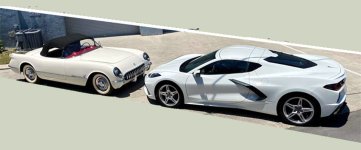You are using an out of date browser. It may not display this or other websites correctly.
You should upgrade or use an alternative browser.
You should upgrade or use an alternative browser.
On Corvettes 69th Birthday GM applies for this Trademark
- Thread starter teamzr1
- Start date
James Vette
CCCUK Member
Maybe they want to start producing and selling old corvette parts online.
Corvetteville
CCCUK Member
Maybe build some "new" old cars, like Jaguar did with the D type.
Stingray
CCCUK Member
Jaguar
Aston Martin
Ferrari
MG (when in 1990s they did the RV8 version of MGB)
they're all at it.
Next week - "The Austin Rover classic collection"
Marina Sport - iconic styling enhanced with 4-pot turbo power and independent rear suspension.
Metro Metropolis - relive the days of Lady Di with a plug-in hybrid for city dwellers.
Eco-Maestro - all electric rebirth of this timeless classic.
Aston Martin
Ferrari
MG (when in 1990s they did the RV8 version of MGB)
they're all at it.
Next week - "The Austin Rover classic collection"
Marina Sport - iconic styling enhanced with 4-pot turbo power and independent rear suspension.
Metro Metropolis - relive the days of Lady Di with a plug-in hybrid for city dwellers.
Eco-Maestro - all electric rebirth of this timeless classic.
James Vette
CCCUK Member
Would be nice to see more classics on the road. I don't care if it's a clone as long as it's exactly the same as the original but I imagine they try and ruin it by adding touchscreens and nasty door buzzers and other modern car bs like that. Not getting my hopes up. Also I thought they couldn't make cars like the good old days anymore because of safety regulations unless you sign a waver when you buy it I guess. I bet the cars are ridiculously expensive as well compared to buying an original.
Roscobbc
Moderator
What /|\ he said. Logic here just has to be that in a world of ever increasing legislation and 'banning' of ICE powered vehicles its a way of them both supporting a network of 10's of thousands of specialist restorers and builders and giving themselves the opportunity to either re-manufacture legal 'new' old cars. Let face it given the option of paying perhaps $80K for a C8 Vette and a re-manufactured C2 or C3 Vette for similar (or more) money that is actually brand new except perhaps for a small part of the chassis and registration number........what would your choice be?Maybe build some "new" old cars, like Jaguar did with the D type.
James Vette
CCCUK Member
I would buy an actual old car because they will overprice it and add nasty modern features.
teamzr1
Supporting vendor
69 years ago today, the first Corvette rolled off a temporary assembly line on June 30th, 1953
Harley Earl was GM’s Head of Styling & the story goes that he was at a race at Watkins Glen in New York to show off his La Sabre concept car when he had the first vision of creating a two-seater sports car that could compete with the likes of Jaguar, MG, and Ferrari.
Code-named “Project Opel” the first prototype was created out of a new construction method utilizing glass reinforced plastic which we refer to today as fiberglass.
Introduced in January 1953 at the GM Motorama show at the Waldorf-Astoria Hotel in New York City, the first Corvette received great reviews and public acclaim for the little white roadster prompted GM to fast-track the Corvette into production.
The first retail models were hand-assembled in the back of the Chevy’s Customer Delivery Center in Flint, Mi, just six months later.
Chevy built 300 Corvettes over the course of the 1953 model year.
A uniform design allowed the workers to concentrate on putting the bodies together without being distracted by trim and equipment variations. Therefore, all 1953 Corvettes were Polo White with Sportsman Red interiors and equipped with a canvas soft-top, 6.70 x 15 whitewall tires, and a Delco signal-seeking radio.
Also, standard was a 5,000-rpm tachometer and a counter for total engine revolutions.
Although some sports car purists took exception to the Corvette’s only available transmission, the 2-speed Powerglide automatic, the Corvette was still a decent sports car with well-tuned examples running 0-60 mph in 11 seconds & having a top speed near 105 mph.
The Blue-Flame 6-Cylinder was reported to make 150 horsepower after engineers gave the engine a more aggressive camshaft, solid lifters, dual valve springs, &a higher compression ratio.
The Corvette’s original base price was set at $3,498.00.
However, the public was hard-pressed to get one as most of the production was doled out to project engineers, GM executives, and other high-profile customers including Hollywood movie stars like John Wayne.
In fact, a dealer notice issued in July ’53 from the Central Office proclaimed:
“No dealer is in a position to accept firm orders for delivery of a Corvette in 1953.”
Chevy would take the first 2 Corvettes off the line and use them for engineering testing, with both eventually destroyed.
That leaves the VIN 003 as the oldest surviving Corvette, but that car isn’t without controversy as the VIN 003 frame was separated from the body for additional testing, and now there are two 1953 Corvettes proclaiming to be the oldest surviving.
As other production-completed Corvettes rolled off the assembly line, Chevy used several as promotional cars, and the “Corvette Dealer Tour” was born. Dealers would get one of Polo White sports cars to display in their showrooms and use the opportunity to bring in customers to see it in person.
The road to success for the Corvette would be slow those first few years and the car was nearly canceled following the 1955 model year, which saw just 700 cars built.
By then, the engineering talents of Zora Arkus-Duntov began paying off as the Corvette would finally see a Chevy V8 installed,
with technological leaps coming later with the addition of a proper 4-speed manual transmission and fuel injection.

Harley Earl was GM’s Head of Styling & the story goes that he was at a race at Watkins Glen in New York to show off his La Sabre concept car when he had the first vision of creating a two-seater sports car that could compete with the likes of Jaguar, MG, and Ferrari.
Code-named “Project Opel” the first prototype was created out of a new construction method utilizing glass reinforced plastic which we refer to today as fiberglass.
Introduced in January 1953 at the GM Motorama show at the Waldorf-Astoria Hotel in New York City, the first Corvette received great reviews and public acclaim for the little white roadster prompted GM to fast-track the Corvette into production.
The first retail models were hand-assembled in the back of the Chevy’s Customer Delivery Center in Flint, Mi, just six months later.
Chevy built 300 Corvettes over the course of the 1953 model year.
A uniform design allowed the workers to concentrate on putting the bodies together without being distracted by trim and equipment variations. Therefore, all 1953 Corvettes were Polo White with Sportsman Red interiors and equipped with a canvas soft-top, 6.70 x 15 whitewall tires, and a Delco signal-seeking radio.
Also, standard was a 5,000-rpm tachometer and a counter for total engine revolutions.
Although some sports car purists took exception to the Corvette’s only available transmission, the 2-speed Powerglide automatic, the Corvette was still a decent sports car with well-tuned examples running 0-60 mph in 11 seconds & having a top speed near 105 mph.
The Blue-Flame 6-Cylinder was reported to make 150 horsepower after engineers gave the engine a more aggressive camshaft, solid lifters, dual valve springs, &a higher compression ratio.
The Corvette’s original base price was set at $3,498.00.
However, the public was hard-pressed to get one as most of the production was doled out to project engineers, GM executives, and other high-profile customers including Hollywood movie stars like John Wayne.
In fact, a dealer notice issued in July ’53 from the Central Office proclaimed:
“No dealer is in a position to accept firm orders for delivery of a Corvette in 1953.”
Chevy would take the first 2 Corvettes off the line and use them for engineering testing, with both eventually destroyed.
That leaves the VIN 003 as the oldest surviving Corvette, but that car isn’t without controversy as the VIN 003 frame was separated from the body for additional testing, and now there are two 1953 Corvettes proclaiming to be the oldest surviving.
As other production-completed Corvettes rolled off the assembly line, Chevy used several as promotional cars, and the “Corvette Dealer Tour” was born. Dealers would get one of Polo White sports cars to display in their showrooms and use the opportunity to bring in customers to see it in person.
The road to success for the Corvette would be slow those first few years and the car was nearly canceled following the 1955 model year, which saw just 700 cars built.
By then, the engineering talents of Zora Arkus-Duntov began paying off as the Corvette would finally see a Chevy V8 installed,
with technological leaps coming later with the addition of a proper 4-speed manual transmission and fuel injection.



